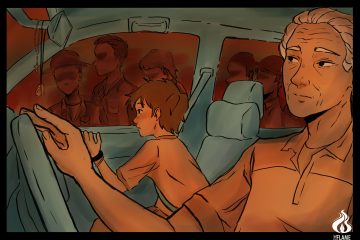By ABIGAIL M. ADRIATICO

BROKEN THINGS can be fixed but they tend to leave scars that cannot be erased. These marks serve as a painful reminder to those that bear them. Although such experiences come with pain, the presence of beauty within those moments can still be felt.
The Japanese art of Kintsugi is the method of using gold to put together pieces of broken pottery. It shows that despite one’s negative experiences, their emotional scars can still be beautiful. However, it also emphasizes that people who try to hide them could end up breaking themselves even more.
The film Kintsugi, directed by Lawrence Fajardo and written by Herlyn Alegre, follows the story of Dante Dizon (JC Santos), an overseas Filipino worker who works at a pottery factory in Japan. It is owned by the father of Harue Matsuzaka (Hiro Nishiuchi), who will inherit the business. Although they initially shared a bad first impression of each other, this changes when Dante discovers more about Harue’s painful past which greatly mirrors his own.
Despite following a typical love story trope, a minor twist causes the narrative to change drastically. From the conflict of lovers struggling to maintain a relationship, it shifts to focusing on the deeper moral dilemmas of the main characters.
Symbols about mending broken things aid in showing this ordeal and how the two characters differ in how they handle it. This difference causes a dispute that throughout the film, they struggle to resolve. This also insinuates the notion that broken people can either heal each other or break themselves further.
Several aspects of the film emphasize how grief drives someone to isolation. This is shown in some scenes where the background takes up more space in the frame than the main characters. It is also reflected in the melancholic background music, with the score prolonging notes and capturing the scene’s emotional gravity. In parts of the film that dwell on the character’s struggles with their past experiences, the use of light shades of blue vividly conveys its somber quality.
The chemistry between Santos and Nishiuchi is palpable during their characters’ romantic scenes. In the scenes where Dante is at his lowest and most isolated, Santos portrayed his character realistically. However, despite the compelling delivery of his lines, his acting in certain parts of the film lacked emotional intensity. This detaches the audience from the dramatic substance of the sequence.
On the other hand, the film touches on the theme of infidelity. This is present in the way Dante actively pursues Harue despite being married back in the Philippines. The way his friend, Phiphi, overlooks this situation makes it all the more distasteful. However, towards the end of the film, it still sends the message that such questionable actions will never lead to something good.
Kintsugi is a film that acknowledges the pain people encounter throughout their lifetime. It shows that though there are people willing to help with their problems, one can only heal if they choose to. It is up to them how they will cope with such feelings, whether healthy or destructive. In the end, it is the acceptance of one’s hardships and inner turmoil that will help them heal and eventually move forward. F



